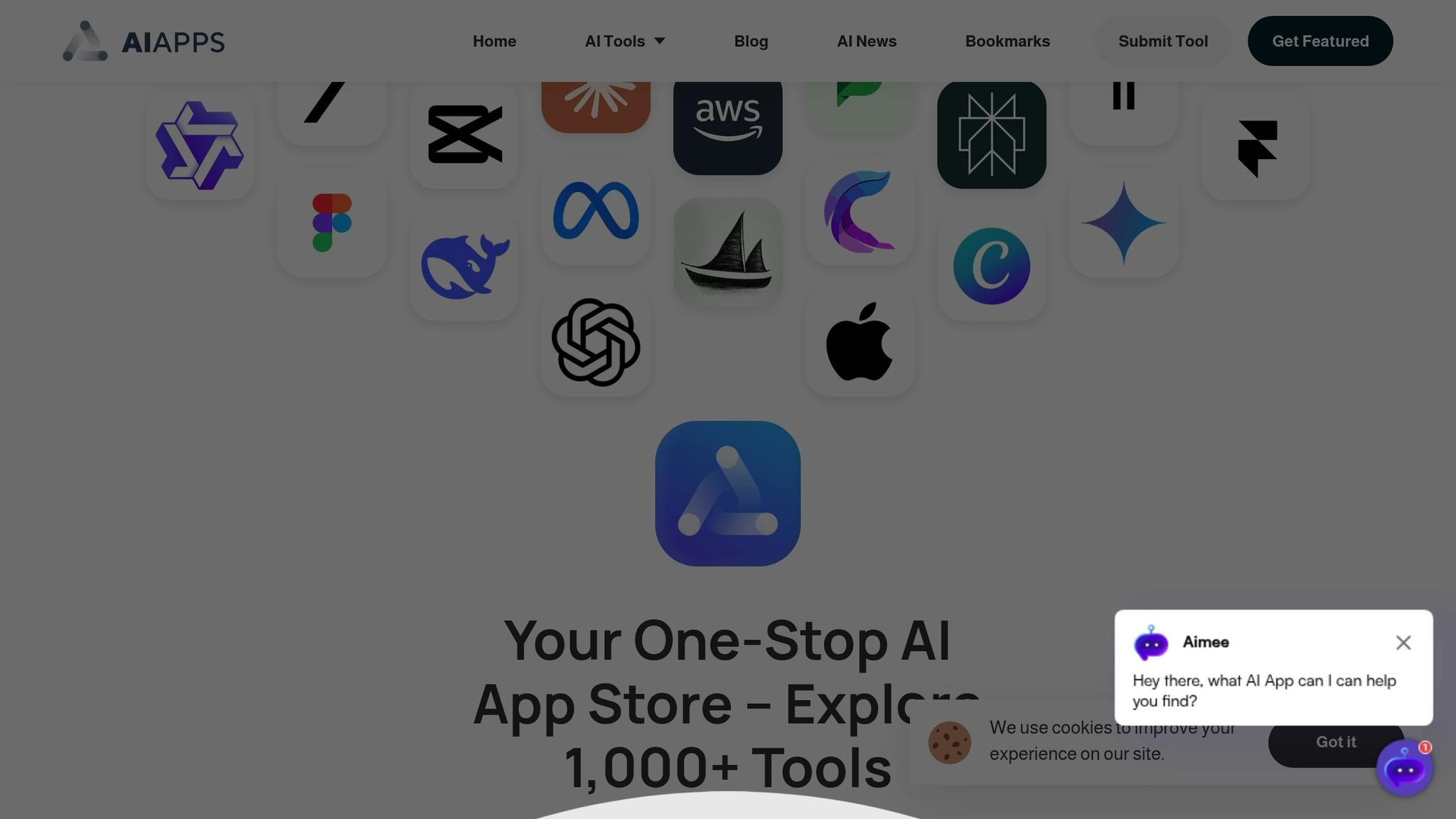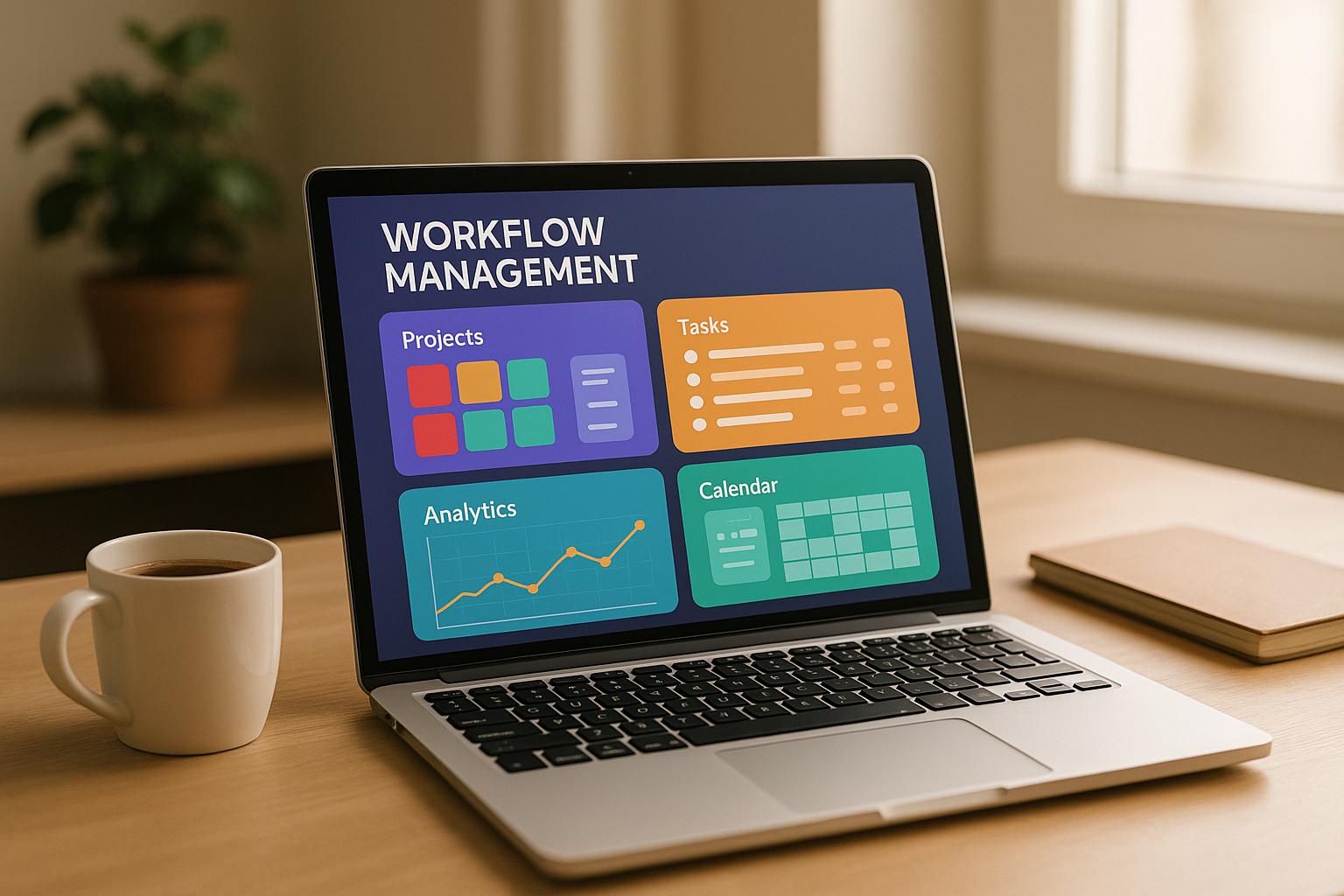AI workflow automation simplifies repetitive tasks like data entry, email responses, and document handling. It uses advanced capabilities such as natural language processing and image recognition to handle unstructured data and make decisions. Here’s what you need to know:
- Why It Matters: Automation saves time, reduces errors, and allows employees to focus on higher-value work. It also operates 24/7, ensuring efficiency across time zones.
- How to Start: Map your workflows to identify repetitive, rule-based tasks. Use tools like AI Apps to find automation solutions tailored to your needs.
- Key Steps:
- Understand Current Workflows: Document every step, decision point, and bottleneck.
- Set Goals: Define measurable outcomes like reducing processing time or error rates.
- Evaluate Tools: Check for system compatibility, security, and scalability.
- Test and Monitor: Pilot automation on non-critical tasks, then refine based on results.
- Best Practices: Maintain data quality, involve your team, and regularly update systems to meet evolving needs.
Start small with one task, measure success, and expand gradually. AI workflow automation isn’t a one-time effort - it’s an ongoing process that requires regular monitoring and fine-tuning to deliver long-term results.
Planning and Preparing for Workflow Automation
Finding Workflows That Need Automation
The first step in successful AI workflow automation is pinpointing the right tasks to automate. Look for high-volume, repetitive processes that follow consistent patterns and have clear inputs and outputs. Examples include customer service ticket routing, invoice processing, data entry from forms, and report generation - tasks that are often time-consuming and prone to errors when done manually.
Manual bottlenecks tend to stand out through employee frustrations or delays in deliverables. Processes like copying data between systems, sending follow-up emails, or updating multiple databases with the same information are prime candidates for automation.
Document-heavy workflows are another area where automation shines. Tasks like extracting key data from contracts, sorting documents into categories, or creating standardized reports based on templates can be streamlined effectively with AI tools.
A practical way to identify automation opportunities is to track how time is spent over a week or two. This can highlight processes that consume significant resources and would benefit from automation. Prioritize tasks that occur daily or weekly, as these are more likely to justify the effort and cost of automation compared to infrequent processes.
Once you've identified the workflows to automate, establish clear, measurable outcomes to guide the process and track success.
Setting Goals and Success Metrics
Defining specific and measurable objectives is critical to ensuring your automation efforts deliver real value. Before diving into tool selection or implementation, outline clear goals for what you want to achieve.
For example, set targets like reducing data entry time from 10 hours a week to just 2, lowering error rates from 3-5% to under 1%, or calculating direct cost savings by factoring in labor costs and tool expenses. Don’t forget to include subscription fees and setup costs in your calculations.
You can also aim for quality improvements, such as faster response times, more consistent results, or better adherence to compliance standards. While these benefits may be harder to quantify, they often provide long-term value to the business.
Establish realistic timelines for reaching these goals. Typically, initial results from workflow automation projects start to surface in 4-6 weeks, with full benefits becoming evident over 3-6 months as processes are fine-tuned.
These metrics ensure your automation initiatives stay aligned with your broader business strategies.
Requirements for Automation Readiness
Before diving into AI tools, it’s essential to ensure your organization is prepared for automation. The most important factor? Data quality. AI tools rely on clean, consistent, and well-organized data to perform effectively.
If your data is scattered across multiple systems or filled with gaps, you’ll face challenges during automation. Invest time in cleaning and standardizing your data before introducing AI tools to avoid unnecessary headaches.
Gaining team support is equally important. Employees need to understand how automation will impact their roles and why it’s beneficial - not just for the company, but for them too. Address concerns about job displacement by emphasizing that automation tackles repetitive tasks, allowing employees to focus on more meaningful, strategic work.
Assign a technical lead to oversee the automation process. While this person doesn’t need to be a programmer, they should have a solid understanding of how your systems connect and be comfortable navigating new software. This role is key to keeping the project on track and meeting your goals.
Don’t overlook security and compliance requirements. Ensure the AI tools you select meet your industry’s data protection standards and maintain proper audit trails. This is especially critical for industries like healthcare or finance, where regulations are stricter.
Finally, plan your budget carefully. Factor in both the initial setup costs and the ongoing expenses, such as subscriptions and maintenance. A good rule of thumb is to allocate 10-20% of your initial investment for ongoing costs during the first year. This ensures you’re prepared for updates, monitoring, and adjustments as your automation system evolves.
Selecting and Integrating AI Tools
Finding AI Tools with AI Apps

With thousands of AI tools out there, figuring out where to start can be overwhelming. That’s where AI Apps comes in. It simplifies the process by offering a curated collection of over 1,000 AI tools across various categories. Whether you’re looking to automate customer service, speed up data processing, or improve content creation, AI Apps helps you discover and compare tools tailored to your needs.
The platform organizes tools into categories like automation, text creation, image generation, and video editing. You can use advanced filters to sort by subcategories or pricing models, ensuring you find options that align with your workflow and budget.
What makes AI Apps stand out is its multi-step verification process for quality control. By listing only vetted tools, it saves you from wasting time on solutions that might not deliver. Plus, the platform highlights both established tools and new releases, so you’re always in the know about the latest options.
Once you’ve identified tools that pique your interest, the next step is to evaluate their technical compatibility and security features.
Evaluating Tool Features and Compatibility
After narrowing down your options, it’s time to dig into the details. Start by assessing how well the tools integrate with your existing systems. The best tools should connect easily to your software stack without requiring extensive custom development.
Look for tools with API access and pre-built connectors for widely used platforms like Salesforce, Microsoft Office 365, Google Workspace, or your CRM. Clear API documentation and active support are key indicators of a reliable tool that can adapt to your long-term needs.
When handling sensitive data or working in regulated industries, security and compliance should be top priorities. Check for features like encryption, audit trails, and certifications such as HIPAA for healthcare or SOC 2 Type II for financial services.
Ease of use is another critical factor. Tools with low-code or no-code interfaces can speed up implementation and reduce the need for ongoing IT support. This is especially useful if your team has limited programming expertise or if you want non-technical users to manage workflows independently.
You’ll also want to evaluate the tool’s scalability and pricing model. Some charge per transaction, while others use subscription plans. Be sure to calculate the total cost of ownership over 12-18 months, factoring in setup fees, training costs, and any potential overage charges as your usage grows.
Finally, prioritize tools with strong customer support. Comprehensive knowledge bases, video tutorials, and responsive support teams can save you a lot of time during setup and troubleshooting.
Integration Best Practices
Once you’ve selected your tools, it’s time to integrate them into your workflows. Start small with a pilot integration on a non-critical process. This lets you test compatibility and refine your approach without risking disruptions to essential operations.
Make sure the data flows in your AI tools align with your documented workflows. Setting things up correctly from the start helps avoid inconsistencies down the line.
For long-term success, establish clear naming conventions and folder structures for your automated workflows. As your automation efforts grow, having an organized system will make maintenance and troubleshooting much easier. Use descriptive names that clearly indicate the workflow’s purpose, triggers, and outcomes.
Before going live, test the integration with real data. Run tests at different times and under varying conditions to catch edge cases or formatting issues. Also, create backup and rollback procedures so your team can revert to manual processes if needed. This safety net makes the transition to automation smoother and less stressful.
During the first few weeks after implementation, monitor your integrations closely. Set up alerts for failed processes and schedule regular check-ins to review performance. Most issues tend to surface in the first 30 days, so staying proactive can prevent small problems from becoming major headaches.
Lastly, plan for regular maintenance windows to update integrations, review metrics, and make adjustments as needed. Automation isn’t a “set it and forget it” solution - ongoing tweaks ensure it keeps up with evolving business needs and software updates.
Step-by-Step Implementation Process
Mapping and Documenting Current Workflows
Before diving into automation, you need a clear picture of how your existing processes operate. Start by documenting each step of your workflows in detail.
Observe how your team works to pinpoint decision points, bottlenecks, and repetitive tasks that consume time. Take note of key details like who’s responsible for what, the timing of each step, where data comes from, and how it’s processed. Pay special attention to moments that require human judgment and how exceptions are handled - these will be critical when setting up your AI systems.
Create a visual flowchart to illustrate how information moves between teams and systems. Look for inefficiencies, like manual data entry being repeated in different places or inconsistent processing methods across departments. These gaps can disrupt AI performance.
Make sure to document your data thoroughly: identify data sources, required fields, acceptable formats, and validation rules. This helps prevent errors and ensures your AI tools function as intended.
Once your workflows are mapped out, you’ll be ready to move on to controlled AI testing.
Deploying and Testing AI Solutions
AI solutions require a careful testing phase. Unlike traditional software, AI tools can behave unpredictably when exposed to new data, so testing in a controlled environment is essential.
Begin with a pilot test using historical data. This allows you to compare the AI’s outputs with known results without affecting live operations. Run multiple scenarios, as AI systems can produce different outcomes even when given the same inputs.
Test for edge cases and data-quality issues by using incomplete records, unexpected formats, or unusual conditions. It’s worth noting that over 37% of organizations report AI quality and trust as major challenges when scaling AI in production.
Set benchmarks for performance before going live. Measure current processing times, error rates, and resource usage to establish a baseline. These metrics will help you evaluate whether the AI is genuinely improving efficiency.
For a smoother transition, run AI systems alongside manual workflows for about 30 days. During this time, document any discrepancies between the two approaches.
To stay on top of performance, set up automated alerts for key indicators like processing volumes, completion rates, and error frequencies. These alerts allow you to address issues as soon as they arise.
Once the testing phase confirms reliable performance, integrate AI outputs into your operations with human oversight.
Combining AI with Human Workflows
The best results come from blending AI with human expertise. Use AI to handle routine tasks while reserving complex decision-making for your team.
Introduce human checkpoints at critical stages of your automated workflows. For instance, in high-stakes areas like financial approvals or customer communications, let the AI prepare drafts or recommendations that your team can review and finalize. This approach reflects the reality that only 30% of organizations have fully integrated AI into their daily operations.
Set up clear escalation protocols for cases the AI can’t handle. Define triggers that automatically route these tasks to human reviewers, ensuring that unusual or complex scenarios are addressed properly.
Training your team is essential. Teach them how to interpret AI outputs, when to override automated suggestions, and how to provide feedback that enhances the system’s performance. A lack of staff buy-in and proper change management is a key reason why 63% of AI projects fail.
Feed human corrections back into the AI system to enable continuous learning and improvement. Schedule regular reviews to audit the AI’s accuracy and check for biases, documenting any recurring issues to refine your workflows.
Don’t forget about regulatory requirements. Many decisions, especially in areas like finance or healthcare, require human oversight by law. With 38 states enacting nearly 100 AI-related measures in 2025, maintaining clear records of human involvement in automated processes is critical for compliance.
This ongoing collaboration between AI systems and human oversight ensures a balanced and effective integration.
sbb-itb-212c9ea
Monitoring, Optimization, and Best Practices
Tracking and Measuring Performance
To effectively monitor your AI workflows, start by identifying the key performance indicators (KPIs) that directly influence your business outcomes. Avoid getting distracted by flashy metrics that don’t contribute to actionable insights. The goal is to focus on what truly drives decisions.
Dashboards are invaluable for tracking metrics like processing times, error rates, throughput, and cost savings. For instance, if manual invoice processing previously took 45 minutes per document, compare that baseline to your AI system’s performance. This helps you measure tangible improvements.
Accuracy is another critical metric. Compare AI outputs to expected results and set error thresholds based on the task. For example, financial calculations might demand 99.9% accuracy, while tasks like content categorization can perform well at 95%.
User adoption is equally important. Metrics like login frequency, feature usage, and support ticket volume can reveal whether your team is effectively using the AI system. Low adoption rates often point to issues like insufficient training or poorly designed workflows that need immediate attention.
When analyzing costs, don’t just look at direct savings. Factor in hidden expenses like software licensing, maintenance, training, and ongoing optimization. Many businesses find their actual ROI differs from initial expectations when these additional costs are considered.
Finally, configure alerts for performance dips, error spikes, or bottlenecks. Early warnings can help you address small issues before they disrupt operations. These metrics create the foundation for continuous improvement.
Continuous Improvement Strategies
AI workflows need regular tuning to keep up with evolving business needs and shifting data patterns. This ensures your automation continues delivering value over time.
Monthly performance reviews are a good starting point. Retrain models with updated data, collect structured user feedback, test new features, and refine automation rules. Document these changes to build a knowledge base for your team.
Data drift is a common challenge. As customer behavior shifts or new product lines emerge, models trained on outdated data may lose effectiveness. Regularly updating your data ensures your AI stays relevant.
Encourage feedback through surveys, focus groups, or check-ins with key stakeholders. These insights often reveal inefficiencies or opportunities that metrics alone might miss.
The AI field evolves quickly, and new tools or features may address challenges that seemed unsolvable during initial implementation. Stay informed about advancements to identify opportunities for improvement.
Early automation rules tend to be conservative for reliability. As you gain experience, you can refine thresholds, broaden the scope of automation, or adjust decision criteria to improve performance. This ongoing refinement keeps your workflows efficient and effective.
Best Practices for Long-Term Automation
Sustaining AI automation requires a strategic approach that extends beyond the initial setup. Following these practices can help you maximize long-term benefits:
- Start small and scale up. Begin with simple, repetitive tasks that have clear success criteria. Gradually expand to more complex processes as your team becomes more comfortable. This reduces risks and provides valuable learning opportunities.
- Maintain data quality. AI systems are only as effective as the data they process. Set up validation protocols, regular clean-up routines, and clear data entry guidelines to prevent quality issues from undermining performance.
- Invest in user training. Equip your team with the knowledge to understand AI decision-making, trust its outputs, and provide meaningful feedback. A well-trained team is more likely to embrace automation and drive its success.
- Plan for scalability. Choose tools and architectures that can grow with your business. Consider factors like processing capacity, integration options, and licensing models to ensure your system can handle future demands.
- Prioritize security and compliance. Protect sensitive data with access controls, encryption, and audit trails. Stay updated on industry regulations, as compliance standards for AI are constantly evolving.
- Build redundancy. Have manual backup processes ready for critical workflows in case your AI system fails or produces unexpected results. Regularly test these fallback procedures to ensure they’re effective when needed.
- Encourage continuous learning. Keep your team informed about advancements in AI and best practices. Promote experimentation with new tools while maintaining oversight and managing risks responsibly.
Build Your First AI Automation Workflow in 14 Minutes (No code)
Conclusion
This section brings together the key points for successfully incorporating AI into workflow automation, based on the guidance provided earlier.
Main Takeaways
To effectively automate workflows with AI, careful planning is essential. Start by identifying tasks that will genuinely benefit from automation. The tools you choose play a major role, so it's worth using platforms like AI Apps to explore a variety of AI tools tailored to your needs. Always prioritize tools that integrate well with your current systems and can adapt as your business grows, instead of creating isolated solutions.
Testing is critical. Before rolling out any AI solution, document your existing workflows, conduct thorough testing in controlled environments, and ensure human oversight during the transition. This approach minimizes disruptions and builds trust in the new systems.
Regular updates and improvements are what set successful AI implementations apart. Workflows evolve, data changes, and new technologies emerge. By regularly reviewing performance, gathering user feedback, and refining processes, businesses can ensure their automation efforts continue to deliver value over the long term. Treating AI automation as an ongoing process rather than a one-time task leads to better outcomes.
Next Steps for Beginners
For those just starting, begin small. Identify a repetitive, time-consuming task with clear metrics for success - such as data entry, email categorization, or handling simple customer queries. These tasks are perfect for testing automation because improvements are easy to measure.
Use platforms like AI Apps to compare tools based on categories, pricing, and features. Start with free trials or budget-friendly options to test their effectiveness without committing significant resources. This cautious approach allows you to experiment and learn without major financial risks.
Involve your team early in the process. Frontline employees often have valuable insights into daily workflows that managers might not notice. Including them in the planning stages also fosters acceptance and reduces resistance to change.
Set aside time for learning and experimenting. AI workflow automation isn’t a "set-it-and-forget-it" solution. It requires ongoing adjustments and learning. Dedicate resources to training, testing, and fine-tuning your systems. The experience you gain from your first project will make future automation efforts smoother and more efficient.
Above all, start now. Don’t wait for the perfect conditions. The AI landscape is constantly evolving, and hands-on experience is the best way to learn. Your first project will serve as a stepping stone, laying the groundwork for more advanced automation as your skills and confidence grow.
FAQs
What steps should I take to prepare my data for effective AI workflow automation?
To set up your data for smooth AI workflow automation, begin by ensuring it’s clean, consistent, and properly structured. Standardize formats across all datasets - like adopting the YYYY-MM-DD date format - and remove duplicates or unnecessary entries. Fill in missing data, fix structural errors, and flag outliers to enhance the overall quality.
Using automated tools for data profiling and validation can make these steps more efficient. When your data is well-organized and high-quality, your AI workflows are more likely to deliver accurate and dependable results.
How can I involve my team in AI workflow automation and address concerns about job security?
To get your team on board with AI workflow automation, start by fostering open and honest communication. Explain how AI can take over repetitive tasks, freeing up time for employees to focus on more strategic and creative work. Address any concerns about job security head-on to create a sense of reassurance.
Involve your team early in the planning and rollout phases. By seeking their input, you not only build trust but also tap into their unique insights, which can help the implementation process run more smoothly.
Make sure to provide ongoing training and upskilling opportunities so your team feels equipped to use AI tools effectively. Emphasize that AI isn’t here to replace them - it’s here to enhance their roles, making their work more efficient and impactful.
How can I track the success of my AI workflow automation and keep improving it over time?
To gauge how well your AI workflow automation is performing, pay close attention to key performance indicators (KPIs) such as process efficiency, error reduction, and return on investment (ROI). These metrics provide a clear picture of productivity gains and cost savings.
For continuous improvement, make it a habit to review your KPIs regularly. Use performance data to fine-tune workflows and ensure your automation efforts stay aligned with your broader business goals. This flexible approach helps maintain momentum and supports long-term growth.



